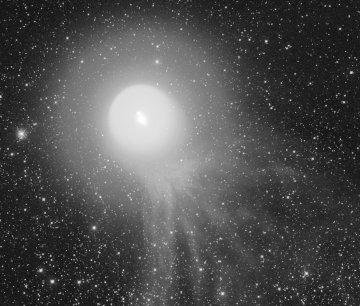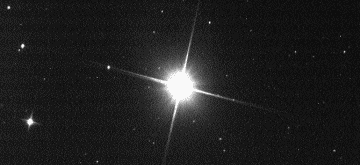Interesting goings on in the cosmic vicinity lately. Comet 8P/Tuttle, made its closest approach to Earth recently, on January 1st coming within 24 million miles. It wasn't huge, but it was green, which is not something you see every day. Apparently the emerald color comes from cyanogen (CN, a poisonous gas) and diatomic carbon (C2) present in the comet's atmosphere; both substances glow green when exposed to UV sunlight in the near vacuum of space. Conveniently it passed by one of the more photogenic galaxies in the night sky.
Comet 8P/Tuttle, made its closest approach to Earth recently, on January 1st coming within 24 million miles. It wasn't huge, but it was green, which is not something you see every day. Apparently the emerald color comes from cyanogen (CN, a poisonous gas) and diatomic carbon (C2) present in the comet's atmosphere; both substances glow green when exposed to UV sunlight in the near vacuum of space. Conveniently it passed by one of the more photogenic galaxies in the night sky. Comet 17P/Holmes, on the other hand, is gradually fading away and will soon fade into obscurity again, unless it explodes a second time, as it did in 1892 when it was discovered. It could happen. The explosion on October 23rd brightened it a million-fold in just a few days, to the point that it was visible to the naked eye, even in the light-polluted skies above my apartment. By October 28th, the cloud of debris around the comet was larger than Jupiter - and I don't mean to look at in the sky, but quite literally the comet was the largest thing in the solar system except the sun.
Comet 17P/Holmes, on the other hand, is gradually fading away and will soon fade into obscurity again, unless it explodes a second time, as it did in 1892 when it was discovered. It could happen. The explosion on October 23rd brightened it a million-fold in just a few days, to the point that it was visible to the naked eye, even in the light-polluted skies above my apartment. By October 28th, the cloud of debris around the comet was larger than Jupiter - and I don't mean to look at in the sky, but quite literally the comet was the largest thing in the solar system except the sun.
Speaking of the sun, January 4th saw the ringing in of the next solar cycle, heralded by the appearance of the first reversed-polarity sunspot. The solar minimum is officially over, so we've got about 5 1/2 years to work up to the next solar max. Bring on the auroras!
On December 18th, Mars made its closest approach to Earth for a while, coming within 55 million miles, and providing another launch window for probes, which include the NASA rover Phoenix, set to arrive in May.
Speaking of Mars, NASA scientists tracking asteroid 2007 WD5 now say that it will NOT hit Mars on January 30th. When it was discovered last month, astronomers said it was likely to strike the planet, but further observation and orbital calculations has dropped the probability of impact to approximately 0.01% or 1 in 10,000 odds, effectively ruling out the possible collision. I'll admit it, I'm a little disappointed. And speaking of asteroids, on January 10th, asteroid 2005 WJ56 flew past Earth only 2.6 million miles away. The kilometer-wide space rock was close enough for amateur astronomers to photograph as it glided through the constellation Taurus.
And speaking of asteroids, on January 10th, asteroid 2005 WJ56 flew past Earth only 2.6 million miles away. The kilometer-wide space rock was close enough for amateur astronomers to photograph as it glided through the constellation Taurus.
And lastly, asteroid 2008 AF3 flys past Earth today only one lunar distance (240,000 miles) away. No chance of collision, and this rock is only about 27 meters across, but still. It was only discovered 3 days ago.
Scary.
Sunday, January 13, 2008
Not so lonely out in space
Posted by Zach at 2:44 PM
Subscribe to:
Post Comments (Atom)

1 Comment:
Are you sure that it wasn't comet Buttle/27B/6?
Post a Comment